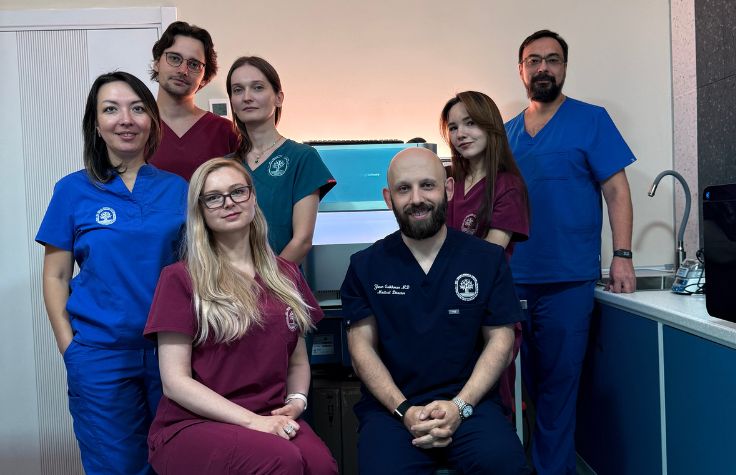
4 November 2024
A researcher looking at a cancerous tumor sample might find it beneficial to separate the tumor cells from the normal cells to see how the bad actors are acting. “Anybody doing gene expression for any organism, mammalian or non-mammalian, is switching to single-cell sequencing because they can disentangle the complexity of what they see in bulk,” says Soroush Zarandi, an Illumina senior manager who works in corporate development but has a background in R&D. Looking at a single cell’s gene expression can help biologists or pharma companies develop targeted drugs for a range of diseases. The research applications are many and diverse.
The field of single-cell research experienced strong growth only in the last decade, as scientists wanted to look at the biology of cells and understand what happens with a particular cell.
“Researchers examine thousands of cells and try to identify a group of them that behave in a similar manner,” explains Illumina Vice President and Global Head of Advanced Science Cande Rogert. “And by looking at those groups of cells, you can infer disease state or healthy state or developmental state or other types of intercellular relationships in an organism.”
To understand the composition of a tissue containing a variety of cell types, researchers can examine its overall RNA expression patterns. This helps them determine the genes that are present and which ones are more or less active. Rogert uses the analogy of a smoothie—a person is able to look at which individual fruits or seeds or vegetables are in the mix and how they are behaving.
Researchers gain fluency in single-cell analysis
Current single-cell methods and products require researchers to use complex and expensive equipment. They take tissue from an organism they want to analyze, separate it into single cells, and then transport the cell suspension liquid to a core lab that processes it on a traditional single-cell instrument and sequences it. This method is not always ideal—if the facility is a 30-minute drive away, a fragile sample may not survive transport.
Now, with new technology from Fluent BioSciences, a Boston company recently acquired by Illumina, a researcher can prep the sample on their own, on site, at the point of cell collection. “Within a few minutes, you can capture cells into individual microdroplets right at the lab bench,” says Zarandi, who helped manage the acquisition with Rogert. “Then you would tag the transcripts associated with each individual cell with a distinct barcode, then prepare libraries for DNA sequencing.” They can send the library out to the central lab for sequencing, or sequence it in their own lab. Either way, they’re reducing the time it takes to get the data. The workflow is easy and accessible enough that it can be done in smaller labs that may not have prep or sequencing capabilities or very many instruments. The Fluent kits are incredibly flexible in that they are capable of processing a range from 200 cells up to 100,000 cells. Therefore, there is a kit format available for all types of projects, small or large.

Fluent’s library prep assay, PIPseq V (Particle-templated Instant Partitioning sequencing), can detect cell types often missed with current methods and enables researchers to sequence vastly more cells for less cost. Another advantage is that PIPseq can process a variety of difficult sample types quite easily: Whether it’s fatty cells like neurons or adipose tissue cells, PIPseq doesn’t deploy any microfluidic channels that could get clogged.
“We were excited about Fluent because PIPseq is a minimal-instrumentation product that lowers the barrier for adoption,” Zarandi says, “and provides advantages like sample flexibility, scale, and cost savings.”
Illumina listened to its customers who want easier, simplified workflows. Providing a sample-to-answer solution, from library prep to sequencing to analysis, satisfies that. And now with the Fluent technology, Illumina can enable more high-throughput applications and single-cell experiments at a scale that was not possible before.
Finding meaningful answers
Illumina will also be able to build on Fluent’s analysis software, PIPseeker, using DRAGEN and a bioinformatics solution called Partek Flow, which Illumina acquired earlier this year.
One of Illumina’s goals is to enable customers to gain insights from their sequencing. “It’s not just about getting two gigabases out of sequencing from an instrument,” says Rogert. “It’s about us helping the customer get actual information from their data.”
Illumina has been working on multiomic solutions with its DNA prep, RNA prep, and, more recently, Protein prep (through a joint development with Standard BioTools), enabling customers to generate and combine data from multiple -omes. And now the company is expanding its multiomics menu beyond workflows for bulk sample types to enable additional modalities, such as single cells. The Partek acquisition enables deep insights from multiomic and multimodal data generated by single-cell assays. “Now Illumina can provide single-cell customers with a much more seamless workflow and interaction for multimodal biology,” Rogert says, “and we continue to support the spatial solutions that exist in the field with our software and informatics.”
By offering beginning-to-end solutions, Illumina can give its customers the flexibility to simplify sourcing tools from multiple suppliers and order just one complete solution, if they choose.
“We’re not looking to replace what is already out there,” Rogert says. “But with our position and capabilities, we wanted to help bring single-cell to labs that haven’t been able to access it before. We want to bring labs a technology that requires minimal instrumentation, has enough sensitivity to do the assays they need to do, and has a simple workflow that doesn’t require specialized people or equipment.”
Bolstered by these new offerings, single-cell research will allow scientists to get even more insights into biology. And hopefully, someday researchers will be able to not just define and organize cell types and their expression, but also understand how they’re spatially related to one another and whether that spatial relationship affects the gene expression of neighboring cells. ◆


